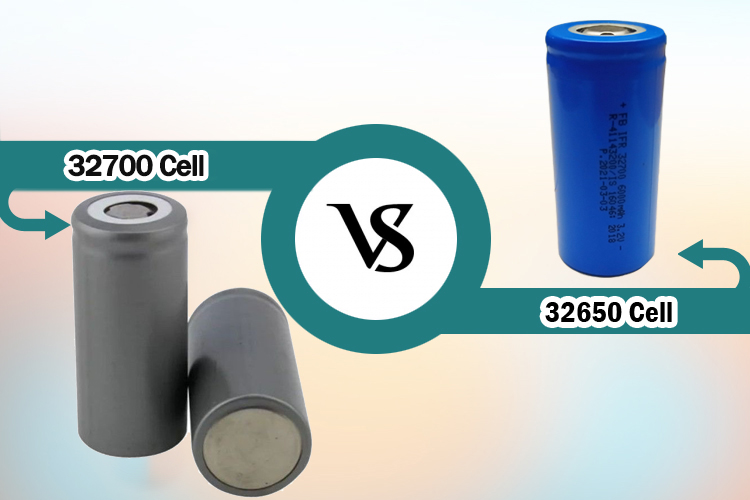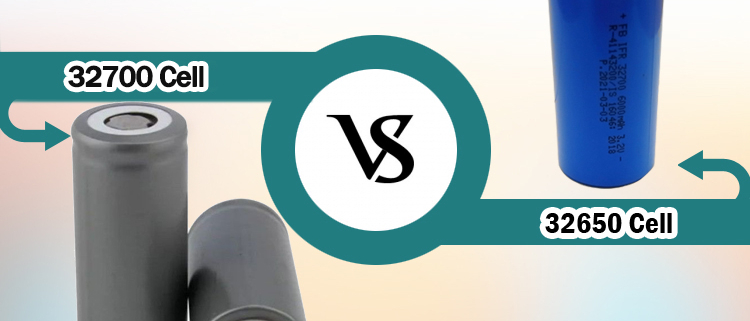What is the differences between 32650 and 32700 battery?
When buying batteries, it can be challenging to understand the differences between particular models. This article will discuss the difference between 32650 and 32700 batteryy, so you can decide what is best for your needs. We will go over the various characteristics of each battery, such as size, voltage, and energy capacity. This article also provides insight into which type of battery suits different applications.

The Size Differences between the 32650 and 32700 battery
The 32650 battery has a cylindrical shape, measuring 32mm in diameter and 67mm in length. On the other hand, the 32700 battery is an updated version of the LiFePO4 32650. Still, it is slightly larger, measuring 32.2 ± 0.3mm in diameter and 70.5 ± 0.3mm in length. In addition, the 32700 battery has a higher capacity than the 32650 battery, with a standard capacity of 6000mAh (at 0.2C discharge). As a result, the 32700 battery offers more power and energy density than the 32650 battery, making it smaller and lighter for the same-capacity battery.
The Voltage Difference
The 32650 and 32700 battery cells are both lithium iron phosphate cells with the same size, but the 32700 cell has a higher capacity than the 32650 cells. The nominal voltage of the 32650 battery is 3.2V. The 32700 battery has a nominal voltage of 3.7V, making it slightly higher than the 32650. The charge rate of both cells is 1C, and the standard capacity of the 32700 cells is 6Ah (at 0.2C discharge). The voltage of shipment for both cells is between 2.8V and 3.2V.
Capacity Differences
The 32650 and 32700 batteries have different capacities. The 32650 cells usually have an ability of 4,000 to 5,000 mAh, while the 32700 cells have a total of 6,000 mAh. The 32700 cells are the updated version of 32650 and can hold more energy than the 32650 cells. Furthermore, 32700 cells can also replace 32650 cells with the same size but higher capacity. ALL IN ONE’s batteries are based on LiFePO4 and can have a residual capacity of at least 80% of their rated power at 1C.
Applications for Each Battery
The 32650 and 32700 batteries are both rechargeable lithium-ion cells featuring LiFePO4 (Lithium Iron Phosphate) chemistry. The 32650 batteries are ideal for applications such as consumer electronics, electric bicycles and scooters, golf carts, home appliances, power tools, and solar energy storage systems, as they are small and lightweight. The 32700 batteries, on the other hand, are typically used in toys, power tools, home appliances, and consumer electronics due to their high capacity and stability with high temperatures. Furthermore, the 32700 batteries are more cost-effective than the 32650 batteries, making them the preferred choice for OEM/ODM applications.
Pros & Cons of Each Battery
The 32650 cells offer a higher energy density than the 32700 cells, meaning that the batteries will be smaller and lighter. This makes them ideal for applications where size and weight are important factors, such as solar projects or portable devices. The 32650 cells also have a longer cycle life, meaning they can be recharged and discharged multiple times without needing to be replaced. However, 32700 cells tend to have a higher maximum continuous discharge rate, making them a better choice for applications that require a high power draw. Additionally, 32700 cells offer excellent resistance to extreme temperatures, making them a better option for outdoor applications.
In conclusion
The 32650 and 32700 batteries are two types of lithium-ion batteries that differ in many ways. While the 32650 is commonly used for small devices such as flashlights, calculators, and digital cameras, the 32700 is used for larger devices like medical equipment and power tools. The 32650 also features a lower capacity than the 32700, but it offers more flexibility regarding the size. Both batteries are reliable and cost-effective choices for a variety of applications.








